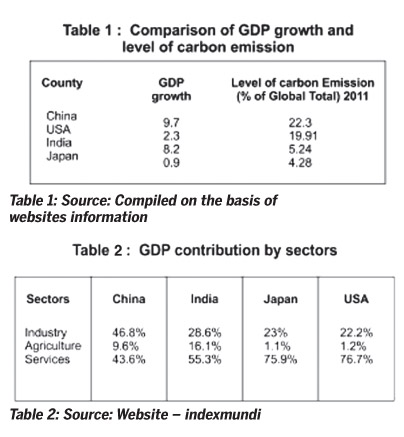Sustainable Development through Compatible Development
Plnr. K.D. Fernando
|

Industrial pollution has a negative effect on environment
|
It is argued that Sustainable Development can be achieved on real
ground through the achievement of Compatible Development in countries.
Compatibility is where things are matched and integrated in the
development processes with less adverse impacts to the environment. This
is achievable through techno-economic and scientific methods pertaining
to logical and rational decision making process in spatial development
planning. Accordingly Compatible Development is in the domain of
integrated spatial planning. This approach ensures the needs of
Compatible Development which marches aspects of physical and technical
feasibility, economic viability, social acceptability and environmental
compatibility.
A review of the validity of the concept of Sustainable Development in
its operation is essential to evolve a planning strategy to address the
above issues within the framework of Compatible Development. Sustainable
Development which was expected cannot be achieved due to inherent
positive as well as negative factors. This was a focus for debates
throughout many decades.
Writer thinks that Sustainable Development is more achievable when
the term sustainability is replaced with the term, compatibility.
Accordingly, on a theoretical basis it will demonstrate the possible
strategies to enhance the validity of Sustainable Development in the
context of its operation through a multi-disciplinary approach based
Compatible Development, within the purview of Integrated Spatial
Development Planning.
Brundtland Report (1987) said: “Sustainable development is
development that meets the needs of the present without compromising the
ability of future generations to meet their own needs of the present
without comprising the needs of future”.
Climate change
 Nevertheless the current global Climate Change phenomenon clearly
indicates environmental issues as a manifestation of the deficiencies in
the approaches of Sustainable Development in its operation. The existing
ecological imbalance and its effects such as global warming, depletion
of ozone layer and carbon emission are adversely affecting the validity
of Sustainable Development. Nevertheless the current global Climate Change phenomenon clearly
indicates environmental issues as a manifestation of the deficiencies in
the approaches of Sustainable Development in its operation. The existing
ecological imbalance and its effects such as global warming, depletion
of ozone layer and carbon emission are adversely affecting the validity
of Sustainable Development.
The current global development trends are being infused with the
unplanned urbanization and its related environmental issues. Countries
are making all efforts to urbanize their population directly and
indirectly through economic development strategies in the absence of
appropriately defined national policy measures pertaining to integrated
agro-urban settlement development as a measure to combat ill effects of
sub-metropolinization, which is the severest negative impacting process
of phenomena which are taking place on natural resources than other
forms of urban sprawl (Fernando, KD 2007). This causes an disequilibrium
between the green spaces(Forestry and agricultural land), blue
spaces(water sheds and its related land) and brown spaces(built up
areas)at a higher magnitude with an irrevocable cost to the economy.
In majority of the countries, the urbanization process is taking
place in a sporadic manner which results in haphazard physical
development by adversely impacting on the green and blue spaces. This is
severely impacting on the blue spaces which are rather essential for the
sustenance of forestry and agricultural spaces which are commonly
understood by any human being. This inter-dependency between green and
blue spaces is essential for their symbioses, which in turn creates a
conducive habitable environment for human beings and other beasts. UN
agencies are shredding crocodile tears in respect of environmental
issues. By and large these agencies are only fattening the payroll of
their so called experts, instead of providing tangible solutions. The
countries with great civilizations such as Sri Lanka should tackle their
environmental issues with their own expertise in the Asian region and be
vigilant of external advice.
The processes of urban sprawl is constantly taking place at different
scales throughout the world. In situ, the conventional definition of
urban sprawl has to be testified in the context of growth scenarios
pertaining to megapolitan and metropolitan development. These scales of
physical urban development and its sprawl have a higher magnitude of
land conversion of adjacent agriculture, forestry and watersheds while
negatively impacting on their biodiversity. The biodiversity is part and
parcel of the ecology system and it is also helping the sustenance of
human ecology in symbiosis with the natural environment.
Development strategies
The world organizations are internally making deliberations by
investing a colossal amount of capital resources to combat the adverse
effects in order to maintain a balance between the human ecological and
the natural ecological systems. It should not be mistaken that
Sustainable Development can be achieved merely by mitigatory measures on
paper. For this purpose it is essential to evolve Compatible Development
strategies which are framed within the purview of integrated spatial
development planning.
The irrational argument that based on the advantages of opportunity
cost obtainable by the investor countries due to relatively low labour
wages and low cost resources available in the host country in sphere of
the extraction and manufacturing industries, the pollutants generated by
such industries in turn will not be affecting cannot be ruled out due to
the atmospheric process of transportability of CO2 by its high emission
levels between those investor and its host countries. This could takes
place from one region to the other. The decisions made by a region, with
the belief that the excess reserve capital could be invested in another
country for economic gains in terms of opportunity cost advantages of
internal economies are disastrous.
This is a consequence which has to be undergone by the so called
developed countries promoting Foreign Direct Investments in developing
countries to exhaustively deplete the natural resources of the host
countries.
Their populations too have to pay the price in terms of its
consequences. The economic advantages will be set off in the form of
diseconomies which is an negative result in development. This is the
Disequilibrium of Economic Development at a global scale with short
sighted scenario building with a higher level of biasness on GDP growth
phenomena.
Therefore the entire world has to come to consensus on rate of CO2
emission by development activities, climate change and the ultimate goal
to be achieved by cutting down the wasteful consumption of resources
without surpassing the equilibrium points of thresholds and its
connected diminishing marginal return of production. According to
Wakernagel, Rees 1997, Wada, 1999 , Daly, 1996 Brundtland’s growth-bound
‘sustainable development’ is not biophysically feasible. Inevitably CO2
emission phenomena is a hindrance in maintaining the level of
sustainability pertaining to development. |



